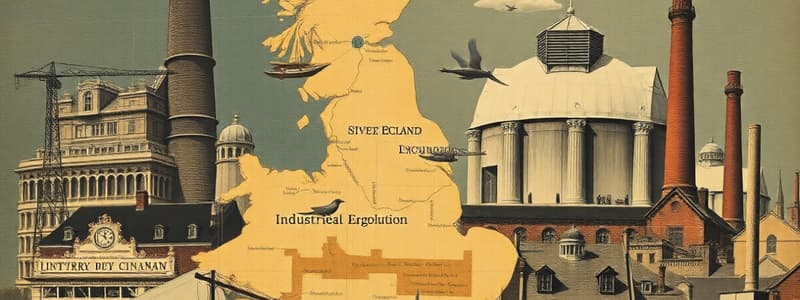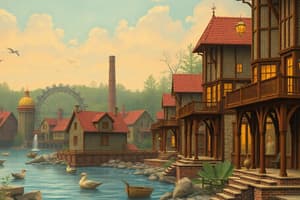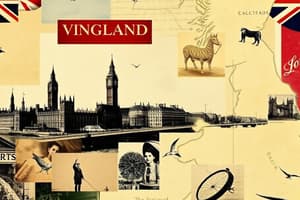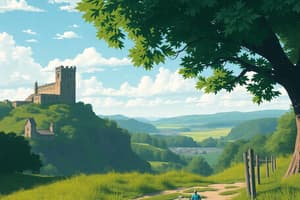Podcast
Questions and Answers
Which geographical feature of the Thames contributed most significantly to London's historical importance as a commercial and trading city?
Which geographical feature of the Thames contributed most significantly to London's historical importance as a commercial and trading city?
- Its path through the Highlands, providing hydroelectric power.
- Its proximity to the North Sea, allowing for deep-sea fishing.
- Its location in the Midlands, facilitating industrial activities.
- Its status as an estuary, allowing ships to sail directly into its port. (correct)
Which of the following factors was NOT a primary contributor to the start of the Industrial Revolution in England?
Which of the following factors was NOT a primary contributor to the start of the Industrial Revolution in England?
- The development of the steam engine.
- The availability of ore for metal production.
- The widespread agricultural production in the Lowlands. (correct)
- The presence of significant coal resources in the Midlands.
What is the term used to describe the traditional textile made from sheep that is commonly associated with Scotland?
What is the term used to describe the traditional textile made from sheep that is commonly associated with Scotland?
- Moor
- Glen
- Tweed (correct)
- Loch
What economic shift is Wales currently undergoing to revitalize its economy?
What economic shift is Wales currently undergoing to revitalize its economy?
Which of the following best describes the physical geography of the Midlands region of England?
Which of the following best describes the physical geography of the Midlands region of England?
Which of these is NOT a term associated with the physical geography of Scotland?
Which of these is NOT a term associated with the physical geography of Scotland?
Historically, what were the primary industries of Scotland before the rise of oil development?
Historically, what were the primary industries of Scotland before the rise of oil development?
What is the currency used by the countries in the European Union, as discussed in the text?
What is the currency used by the countries in the European Union, as discussed in the text?
What does the term 'fertile' refer to in the context of English geography?
What does the term 'fertile' refer to in the context of English geography?
Which of the following best describes the location of the estuary that was significant for London's trading position?
Which of the following best describes the location of the estuary that was significant for London's trading position?
What is the primary composition of peat?
What is the primary composition of peat?
Which of the following best describes the concept of 'Cultural Divergence' as it relates to Ireland?
Which of the following best describes the concept of 'Cultural Divergence' as it relates to Ireland?
What was a direct consequence of the blight in Ireland?
What was a direct consequence of the blight in Ireland?
How did the Protestant Reformation primarily affect the religious landscape of Ireland?
How did the Protestant Reformation primarily affect the religious landscape of Ireland?
What conflict is referred to as 'The Troubles' in the context of Irish history?
What conflict is referred to as 'The Troubles' in the context of Irish history?
What geological feature is created by glaciers and characterized by steep valleys?
What geological feature is created by glaciers and characterized by steep valleys?
Which of the following defines 'Geothermal Energy'?
Which of the following defines 'Geothermal Energy'?
What phenomenon causes the 'Midnight Sun' in regions above the Arctic Circle?
What phenomenon causes the 'Midnight Sun' in regions above the Arctic Circle?
What characterizes 'Mixed Economies' in the Nordic Nations?
What characterizes 'Mixed Economies' in the Nordic Nations?
What is the primary influence of the North Atlantic Drift on the climate of the Nordic region?
What is the primary influence of the North Atlantic Drift on the climate of the Nordic region?
Flashcards
Industrial Revolution
Industrial Revolution
The process where people switched from making goods at home to using factories and machines, fueled by coal resources and the invention of the steam engine.
Moor
Moor
A region in Northern England and Scotland characterized by grassy hills.
Estuary
Estuary
The mouth of a river where it widens and floods, creating a wide area suitable for ships to sail directly into.
Ore
Ore
Signup and view all the flashcards
Tertiary Economic Activities
Tertiary Economic Activities
Signup and view all the flashcards
Glen
Glen
Signup and view all the flashcards
Services
Services
Signup and view all the flashcards
Loch
Loch
Signup and view all the flashcards
Tweed
Tweed
Signup and view all the flashcards
Bog
Bog
Signup and view all the flashcards
Peat
Peat
Signup and view all the flashcards
Cultural Divergence
Cultural Divergence
Signup and view all the flashcards
Blight
Blight
Signup and view all the flashcards
Fjords
Fjords
Signup and view all the flashcards
Geothermal Energy
Geothermal Energy
Signup and view all the flashcards
Midnight Sun
Midnight Sun
Signup and view all the flashcards
Mixed Economies
Mixed Economies
Signup and view all the flashcards
Norden
Norden
Signup and view all the flashcards
Marine West Coast
Marine West Coast
Signup and view all the flashcards
The Troubles
The Troubles
Signup and view all the flashcards
Study Notes
World Geography: Chapter 14 Review - England
- England's lowlands are fertile, ideal for crops.
- The Industrial Revolution began in England due to coal resources in the Midlands.
- The Industrial Revolution involved shifting from home-based production to factory-based production using machines like the steam engine.
- Ore is a rock containing valuable materials.
- Tertiary economic activities involve services like finance and insurance, not manufacturing.
- Estuaries are the wide mouths of rivers where they flow into the sea.
- London is a major trading city due to its estuary (Thames River) and western location.
- England is divided into highlands, midlands, and lowlands.
- The midlands are heavily populated and have many coal resources.
- Farming is a major activity in the lowlands.
- The Industrial Revolution was a significant historical event due to the shift from home-based production to factory-based production.
World Geography: Chapter 14 Review - Scotland and Wales
- Scotland and Wales are hilly regions in the UK.
- Traditional Scottish industries include mining and shipbuilding, as well as oil development (now).
- Welsh industries traditionally relied on mining, but they are now trying to shift to tertiary economic activities (like finance or insurance).
- Traditional industries in Scotland are in transition, with oil and gas now a dominant economic sector in Scotland.
World Geography: Chapter 14 Review - Two Irelands
- The Great Potato Famine was caused by a plant disease that devastated the potato crops, leading to significant losses of life.
- The Protestant Reformation led to conflict over religious differences and control of Ireland.
- "The Troubles" were years of conflict over Ireland’s political control, largely between Protestants and Catholics.
World Geography: Chapter 14 Review - Nordic Nations
- The Nordic nations (Iceland, Norway, Sweden, Finland, and Denmark) include areas carved by glacial activity/glaciers.
- The Nordic nations have fjords and lakes.
- The Nordic nations use geothermal energy from the earth's heat.
- The region's climate is moderated by the warm current of the North Atlantic.
- Various industries are prevalent in the region such as mining, timber, farming, and fishing.
Studying That Suits You
Use AI to generate personalized quizzes and flashcards to suit your learning preferences.




